[Quanzhou-BRICS] Voices from BRICS Scholars

Richard Michael Levin from National School of Government, South Africa:
Social inequality is increasingly recognized as a central challenge for all governments in both the developed North and the developing South. Deepening social inequality is not inevitable and is a product of human agency. New institutions of global governance of the South, such as BRICS, are uniquely placed to transform global power relations in ways that will build better lives for the majority of the world’s marginalized and impoverished people.

Swaran Singh Jaswal from School of International Studies, Jawaharlal Nehru University, India:
It is from this perspective that BRICS seeks to work together toward building a community with shared destiny for all, in which it aims to enhance openness and inclusiveness in decision-making and creating outcomes for mutual benefit and win-win results. In working toward this objective, BRICS has displayed the greatest strength so far in hosting regular summits, ministerial and other meetings, expanding the number of various consultative mechanisms, as well as in working with consensus to bring about great credibility and respect to itself. Photograph by Dong Ning/China Today

Ronnie Lins from Center China & Brazil: Research and Business (CCB), Brazil:
Given the characteristics of emerging countries, but of “continental dimensions”, BRICS have their more aligned focus of mutual cooperation for economic development that is much correlated with the needs of social inequalities. However, it should be remembered that given the enormous economic and political weight of BRICS in the world context, all the major world issues must inexorably have their participation and influence.

Mahendra Prasad Lama from Jawaharlal Nehru University, India:
The BRICS mechanism has provided a lot of opportunities for China and India to work together, which is very critical. There is huge scope for India and China to cooperate. For example, solar energy. India is planning to generate 100,000 MW of solar energy. India requires technology, while China is a leading solar energy technology provider globally.
